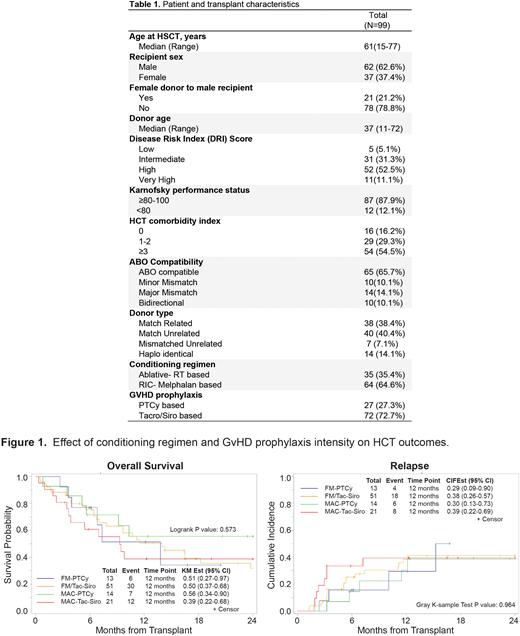Abstract
TP53 mutations are seen in ~ 5-10% of hematological malignancies and 25-40% of patients with therapy related myelodysplastic syndrome (MDS) or acute leukemias (AML and ALL). Several studies have demonstrated inferior survival outcomes in patients with TP53-mutated AML/MDS with 3-year overall survival (OS) of 10-20% regardless of chemotherapy used. Furthermore, data on treatment outcomes in patients TP53-mutated disease after allogeneic hematopoietic cell transplantation (HCT) is conflicted with some studies reporting no survival benefit with HCT when compared no HCT(HR 0.97) with 3-year OS of 11%; and other studies showing a trend towards longer survival in those who underwent allogeneic HCT (14.5 months vs 7.9 months; p=0.09).This conflicting results may be at least partially due to heterogeneity in conditioning / graft-versus-host disease (GvHD) prophylaxis regimens. Here, we aimed to describe treatment outcomes in TP53-mutated patients who underwent different combinations of conditioning regimen intensity [fludarabine and melphalan (FM) as reduced intensity conditioning (RIC) or radiation-based myeloablative conditioning (MAC)], and GvHD prophylaxis regimens [post-transplant cyclophosphamide (PTCy) or tacrolimus/Sirolimus (T/S)].
We retrospectively studied 99 patients with TP53 mutated acute leukemias (AML 48.5%, ALL 23.2%) or MDS (28.3%) who underwent HCT with mobilized peripheral blood stem cell (PBSC) as graft source between January 2015 and December 2021. TP53 mutations confirmed by deletion of chr17/17p using FISH/cytogenetics or by HopeSeq NGS were included. Table 1 details patient and HCT characteristics. The median age was 61 years (range: 15-77 years), and 62.6% of patients were males, 87.9% had a KPS >80, 63.6% had a high/very high DRI score and 54.5% had a HCT co-morbidity index ≥3. Donors were matched unrelated or matched sibling in 40.4% and 38.4%, respectively. Conditioning regimen was either radiation (RT) based MAC (n=35; 35.4%) or RIC with FM (n=64; 64.6%). GVHD prophylaxis was PTCy-based in (n=27; 27.3%) and T/S-based in (n=72; 72.7%).
For the overall group, 1-year OS, and disease-free survival (DFS) were 48.8% (95% CI: 0.37 -0.59), 36.9% (95% CI: 0.26 -0.47), respectively. Cumulative incidence of relapse (CIR), and non-relapse mortality (NRM) were 36.2% (95% CI: 0.26 -0.46) and 27% (95% CI: 0.18 -0.36), respectively. The cumulative incidence of Day 100 grade 2-4 and 3-4 acute GVHD were 37.4% (95% CI: 0.27 -0.47) and 17.6% (95% CI: 0.10 -0.26). CI of 1 year limited and extensive chronic GvHD were 33.8% (95% CI 0.23 -0.44) and 31.2% (95% CI 0.21 -0.41), respectively.
On multivariate analysis, intensity of conditioning or GvHD prophylaxis did not affect OS when FM was compared with RT-based conditioning (HR: 1.14; 95%CI: 0.65-2.1, P=0.64) and PTCy was compared to T/S- based GvHD prophylaxis (HR: 1.41; 95%CI: 0.74-2.67, P=0.27). Conditioning regimen or GVHD prophylaxis intensity did not affect RFS, CIR and NRM. Patients with a DRI score <3 had a better OS (HR: 2.33; 95%CI: 1.25-4.36, P=0.005), RFS (HR: 2.02; 95% CI: 1.15-3.54, P=0.01) and NRM (HR: 3.56, 95% CI: 1.22-10.39, P=0.014) without an impact on relapse rate. Complex Karyotype was associated with lower OS (HR: 2.72, 95%CI: 1.17-6.35, P=0.015) and RFS (HR: 2.19, 95%CI: 1.08-4.44, P= 0.024) but did not increase CIR or NRM. KPS >80 was associated with better OS, RFS and NRM but not CIR. Figure 1 depicts comparable 1-year OS and CIR among different combinations of conditioning regimens and GVHD prophylaxis of FM-PTCy (n=13), FM-T/S (n=51), RT-PTCy (n=14) and RT-T/S (n=21); with p value of 0.57 and 0.96,
In this large single center study, patients with TP53 mutant acute leukemias or MDS who underwent HCT at our center had 1-year OS of 48.8%. Patients with better KPS and DRI score of < 3 had better OS with no effect on the risk of relapse. Outcomes of TP53-mutated patients undergoing FM-based RIC was comparable to patients with RT-based MAC regimen regardless of GvHD prophylaxis intensity. Our data provide insight on possible strategies for patient selection and optimization of pre-/post-HCT management and indicates that improving transplant outcomes in patients with TP53-mutated acute leukemias or MDS remains an unmet need.
Disclosures
Koller:Treadwell Therapeutics: Other: Safety Review Committee; Novartis: Consultancy, Membership on an entity's Board of Directors or advisory committees, Speakers Bureau; Takeda: Speakers Bureau. Ball:Oncovalent: Membership on an entity's Board of Directors or advisory committees. Salhotra:Orca Bio: Research Funding; BMS: Research Funding; Kadmon: Other: Advisory board meeting . Aribi:SeaGen: Consultancy. Aldoss:Autolus Limited: Consultancy; Amgen: Consultancy; Agios: Consultancy, Honoraria; AbbVie: Consultancy, Research Funding; Kite: Consultancy; Jazz Pharmaceuticals: Honoraria, Speakers Bureau. Artz:Abbvie: Honoraria; Magenta: Honoraria. Ali:Abbvie: Membership on an entity's Board of Directors or advisory committees; Bristol Myers Squibb: Membership on an entity's Board of Directors or advisory committees; Incyte Corporation: Membership on an entity's Board of Directors or advisory committees, Speakers Bureau. Stein:Amgen: Speakers Bureau. Marcucci:Agios: Other: Speaker and advisory scientific board meetings; Novartis: Other: Speaker and advisory scientific board meetings; Abbvie: Other: Speaker and advisory scientific board meetings. Nakamura:Kadmon: Consultancy; Magenta Therapeutics: Consultancy; Helocyte Inc: Research Funding; BluebirdBio: Consultancy; Sanofi: Consultancy; Omeros: Consultancy. Al Malki:Hasna Biopharma: Membership on an entity's Board of Directors or advisory committees; Gilead: Consultancy, Research Funding; Miltenyi Biotec: Consultancy, Research Funding; NexImmune: Consultancy, Research Funding; CareDx: Consultancy, Research Funding; Incyte: Consultancy, Research Funding.
Author notes
Asterisk with author names denotes non-ASH members.


This feature is available to Subscribers Only
Sign In or Create an Account Close Modal